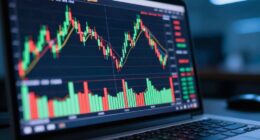Perpetual swaps, those relentless financial beasts, let traders wager on cryptocurrency prices indefinitely, dodging expiration with ruthless cunning, yet they’re a double-edged sword, slicing through naive assumptions. They align prices via funding rates—hourly adjustments, cold and calculated, rewarding or punishing based on market whims, daring anyone to ignore the volatility. Leverage amplifies gains, sure, but obliterates accounts in a flash, mocking the reckless. Stick around; deeper truths await the bold.

Behold the enigma of perpetual swaps, a financial instrument that dares to defy the very concept of finality with its audacious lack of an expiry date. Unlike the staid, predictable world of traditional futures, these derivatives sneer at deadlines, inviting traders—be they institutional giants or lone speculators—to gamble indefinitely on cryptocurrency prices without clutching the underlying asset. It’s a seductive trap, isn’t it, promising endless opportunity while concealing a viper’s nest of peril?
Dive deeper, and the mechanism reveals its cunning. Perpetual swaps cling to spot prices through Funding Rates, those periodic adjustments—often hourly—that either bleed traders dry or toss them a pittance in rebates, all to maintain a fragile market equilibrium. This isn’t charity; it’s cold, calculated efficiency, ensuring the swap price doesn’t drift into absurdity. Yet, question this: who truly benefits when these rates, determined by price disparities, quietly erode profits or pad them, depending on the market’s fickle mood? Traders, beware—ignorance here is a costly sin. This unique feature allows positions to be held indefinitely without expiration. Moreover, these swaps enable institutions to engage in crypto markets with familiar mechanisms like cash settlements, minimizing the operational challenges of holding digital assets. These funding rates also act as a balancing force, as they are exchanged between long and short position holders to align contract prices with spot market values.
Then there’s the siren call of leverage, amplifying gains but magnifying Leverage Risks to a terrifying degree. With collateral deposited, traders can inflate exposure, betting big on price swings, long or short, as if invulnerable. But let’s not romanticize this; it’s a tightrope over a chasm. One volatile jolt in the crypto market, and losses multiply, wiping out accounts faster than one can blink. Profit, calculated as the gap between entry and exit prices times the swap volume, becomes a cruel mirage if risks aren’t managed with iron discipline. So, ponder this with a smirk: are perpetual swaps a brilliant innovation or a reckless game, daring traders to outsmart a beast that never sleeps? Face the reality—tread wisely, or be devoured.
Frequently Asked Questions
What Are the Tax Implications of Trading Perpetual Swaps?
The tax implications of trading perpetual swaps are significant. They often fall under ordinary Income Classification, not qualifying for capital gains. Tax Deductions may be limited, and reporting requires careful compliance with IRS guidelines.
How Do Perpetual Swaps Affect Market Volatility?
Observing market fluctuations, one notes that perpetual swaps substantially influence volatility trends. Their high leverage amplifies price swings, often intensifying rapid market movements and contributing to pronounced instability during periods of aggressive trading activity.
Are Perpetual Swaps Regulated in All Countries?
Regarding whether perpetual swaps are regulated in all countries, Global Regulation remains inconsistent. Enforcement Variations exist, as some nations impose strict rules while others lack frameworks, creating a fragmented regulatory landscape worldwide.
What Risks Are Unique to Perpetual Swaps?
Examining the risks unique to perpetual swaps, observers note that Funding Risks pose significant challenges due to fluctuating rates. Additionally, Liquidation Events can swiftly wipe out positions, amplifying financial losses in volatile markets.
Can Beginners Easily Trade Perpetual Swaps?
Beginners may find trading perpetual swaps challenging due to their complexity. Utilizing Beginner Tutorials can help, and a user-friendly User Interface on trading platforms can ease navigation, though significant learning is still required.









